Create and lead your undead squads to take over the world in this tactical turn-based RPG.
Type: Single-player
Genre: RPG, Strategy
Turn-based Tactics
Developer: Unfrozen
Publisher: Daedalic Entertainment
Release date: 23 Apr, 2020


Premise and Story
Ever wanted to take on the role of the Necropolis faction from Heroes of Might and Magic games but with the combat system of Darkest Dungeon? Then look no further. In here we are on the side of evil, playing as the necromancer Iratus, awakened from centuries of slumber to make this world his own. But before we can do this, we need to purge all the resistance. The humans, dwarves, elves, and mages will mount many attacks to try and stop us. They might be numerous, but with powers of necromancy and the dark arts at our disposal, we might just be able to turn the tide.
There isn’t much else to the story and it’s rather simple in that regard, but a game like this you’re not likely to play for the story. So, let’s cover all the aspects of gameplay.
Gameplay – Combat and Minions
Combat will remind you of games such as Darkest Dungeon straight away. Your team consists of up to 4 minions, and you face off against enemy teams of up to 4 in a squad as well in a turn-based fashion. The positioning matters, just as with other similar games. So, your tanks and melee fighters are best in the front positions, while your mages and glass cannons are in the back positions. Each minion and enemy has a set of skills which can be used from specific positions and target specific positions on the opposing side. For example, one of your characters might have a powerful melee attack that might only be possible to use if they are in positions 1 and 2 (the front) and be unavailable if this character has been pushed to the back (or moved to the back on their own). So, where in the team we put the minions requires a careful consideration.
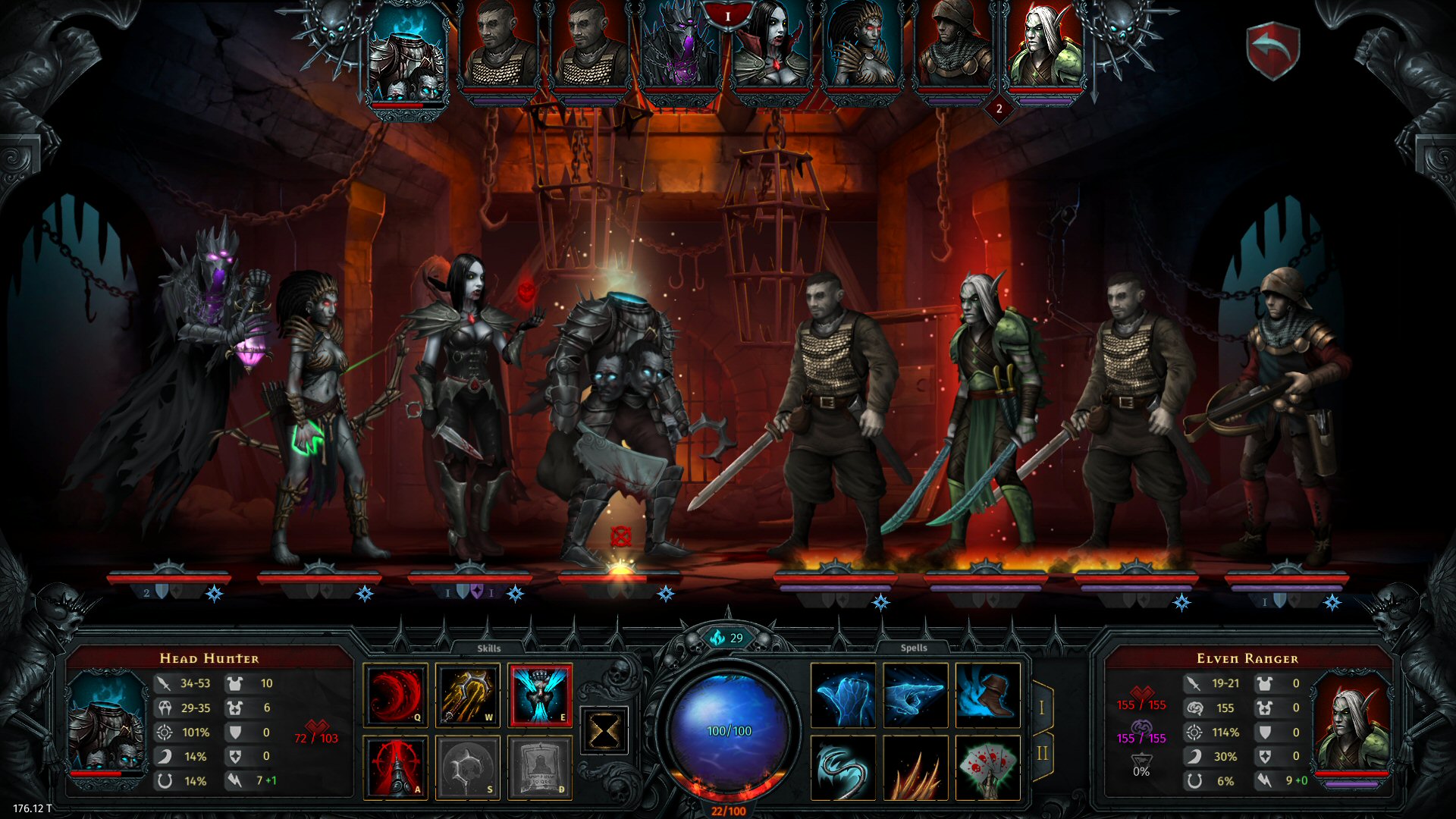
In this game we can use a big variety of different minions in our squad, all fitting to the theme of undead monsters and the like, such as skeletons, vampires, wraiths, banshees, mummies, and so on. Each minion has a unique look, a unique set of 6 skills (1 or 2 of which is a special and requires the use of wrath points during battle), and ability to level up and acquire talent points. Talent points come in two varieties – skill points, used to upgrade the battle skills themselves, and attribute points, used to upgrade minion’s stats such as attack power, health, and so on.
In the very beginning we only have 6 available minion types. All the others we need to unlock by completing various tasks, such as killing a certain number of enemies, driving a certain number of enemies insane, and so on. As of the moment of writing this, there are 19 different minions in total. However, future DLCs could add more to that number. By making most minions locked at the start, the game introduces us to each one gradually so that we don’t get overwhelmed too quickly. As I kept unlocking each one, I was feeling a tonne of excitement as I was keen to quickly test out my new minion type in battle. Another great thing with this system is that once you’ve unlocked a minion, they become available to any new games you might start, so you don’t need to unlock them all over again. In fact, the progress to unlocking each minion is retained across all new games.
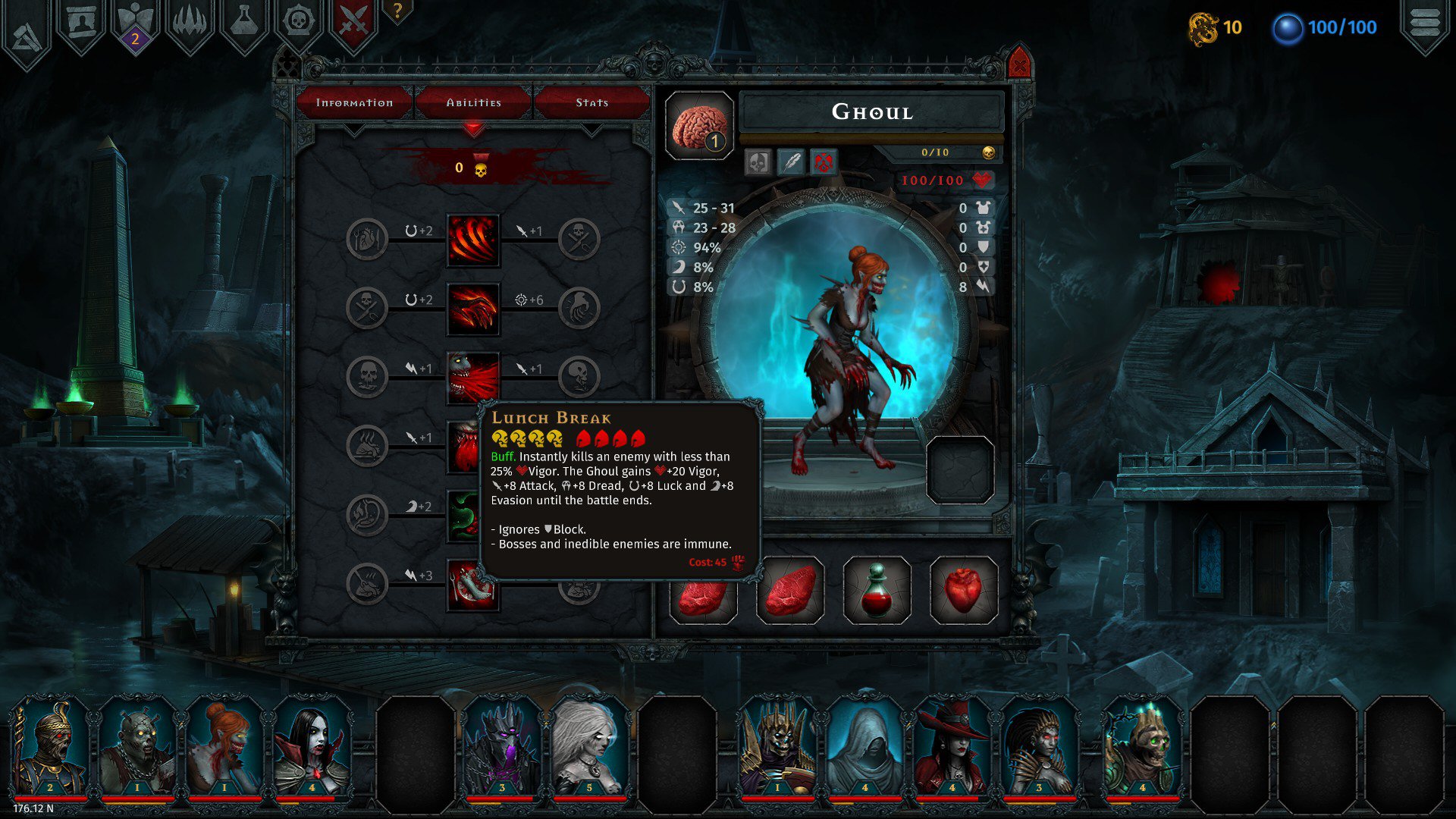
Now that you’ve picked your team of minions, it is time to put them to use and make mortals tremble before you. Yes, you can actually make them tremble literally, because each enemy has not only their regular health bar (vigor), but also their sanity bar. So, in addition to damaging their health, we can also use stress attacks to damage their sanity. As their sanity gets low, they either go insane and receive a heavy debuff, or they get inspired and receive a buff. If their sanity reaches zero, then any subsequent stress damage has a chance to kill them. With this in mind, many of the minions have not only attacks that damage health, but also stress-inducing attacks too, with a small handful of minions being fully-centered on stress damage.
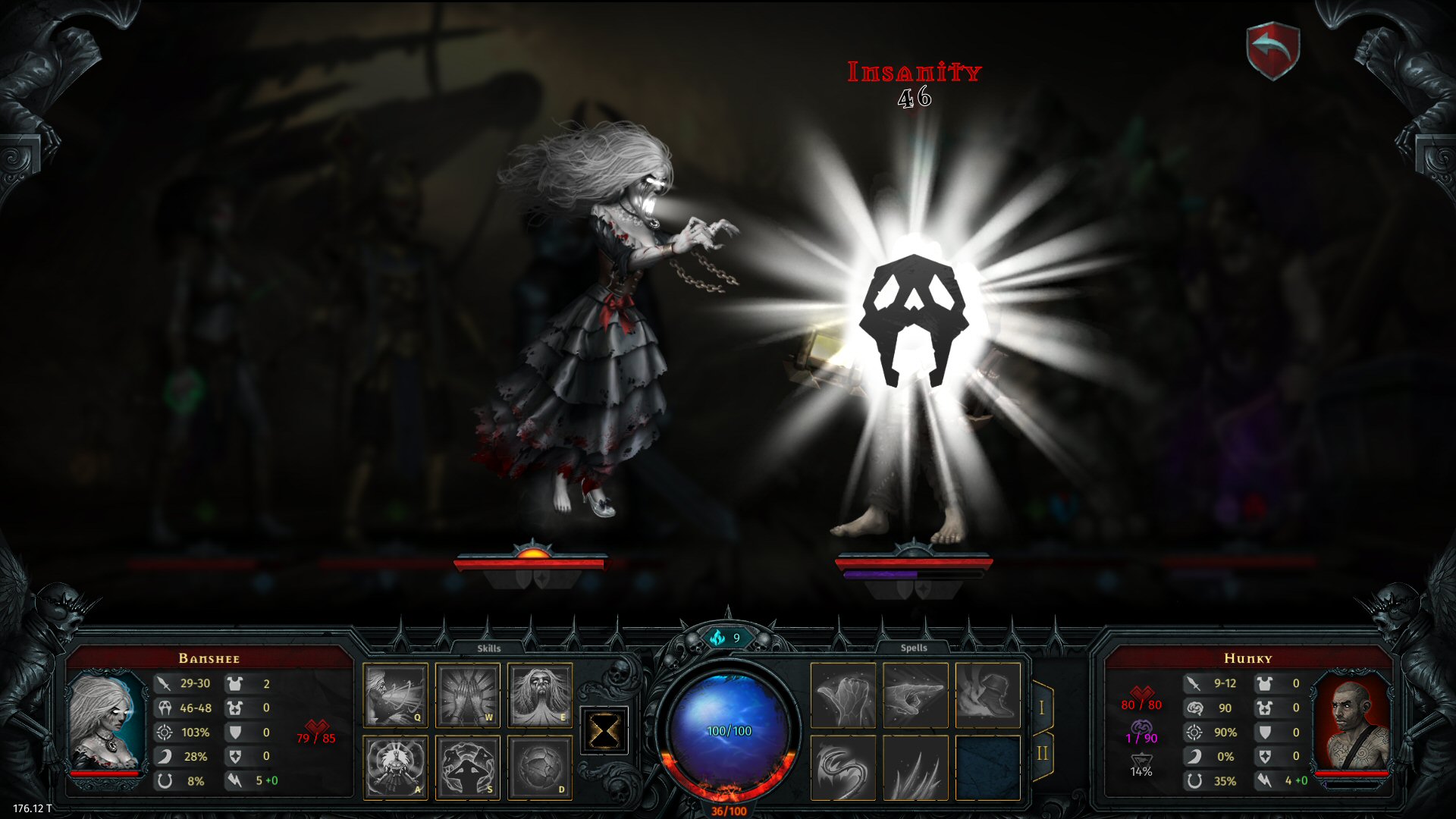
Stress mechanics are a great addition to a game like this as they offer some new ways to defeat the enemy squads. However, in my opinion, stress builds can feel rather underpowered in the latter parts of the game as they rely a bit on luck, whereas HP damage is more reliable (not to mention that some enemies, such as golems, are immune to stress altogether).
Here are a few other key aspects of combat that come up in this game:
- Iratus himself is not just a mere observer in the fights. He can cast spells every turn, some of which could be buffs for his minions, while others could be offensive spells to damage or incapacitate the foes in some way.
- Not all minion abilities are direct attacks. Some act as sort of traps, which are placed on a specific position of enemy troop, and whichever enemy steps into that position gets affected by the trap. Some traps deal damage, others could have other effects, such as preventing enemy from changing their position. Our minions and the human enemies have their own unique traps.
- It is also possible for Iratus or the Liche minion to summon new minions into battle, providing there’s a free space available and they have the sufficient conditions met. This can enable some new strategies where summoned minions are used more as expendable pawns.
- One of the big aspects that affects combat in a very strong way is the Blocks and Wards system. Both minions and human enemies can either start with or acquire via special abilities some blocks and wards. A single block fully absorbs a physical damage attack directed at that character, regardless of how weak or strong the attack is. The same way, a single ward does the same to any magic or stress attack. This opens up ways to tackle powerful enemy attacks and to stop them from causing a dent in our forces if we play our cards right. Likewise, before we can unleash our full fury on the foes, we need to remove or disable their blocks and wards first. In some fights this can feel a bit annoying, but most of the time it adds a nice layer of strategic depth as the game provides many ways of dealing with this obstacle, ranging from individual minion abilities to equipped artifacts on Iratus himself.
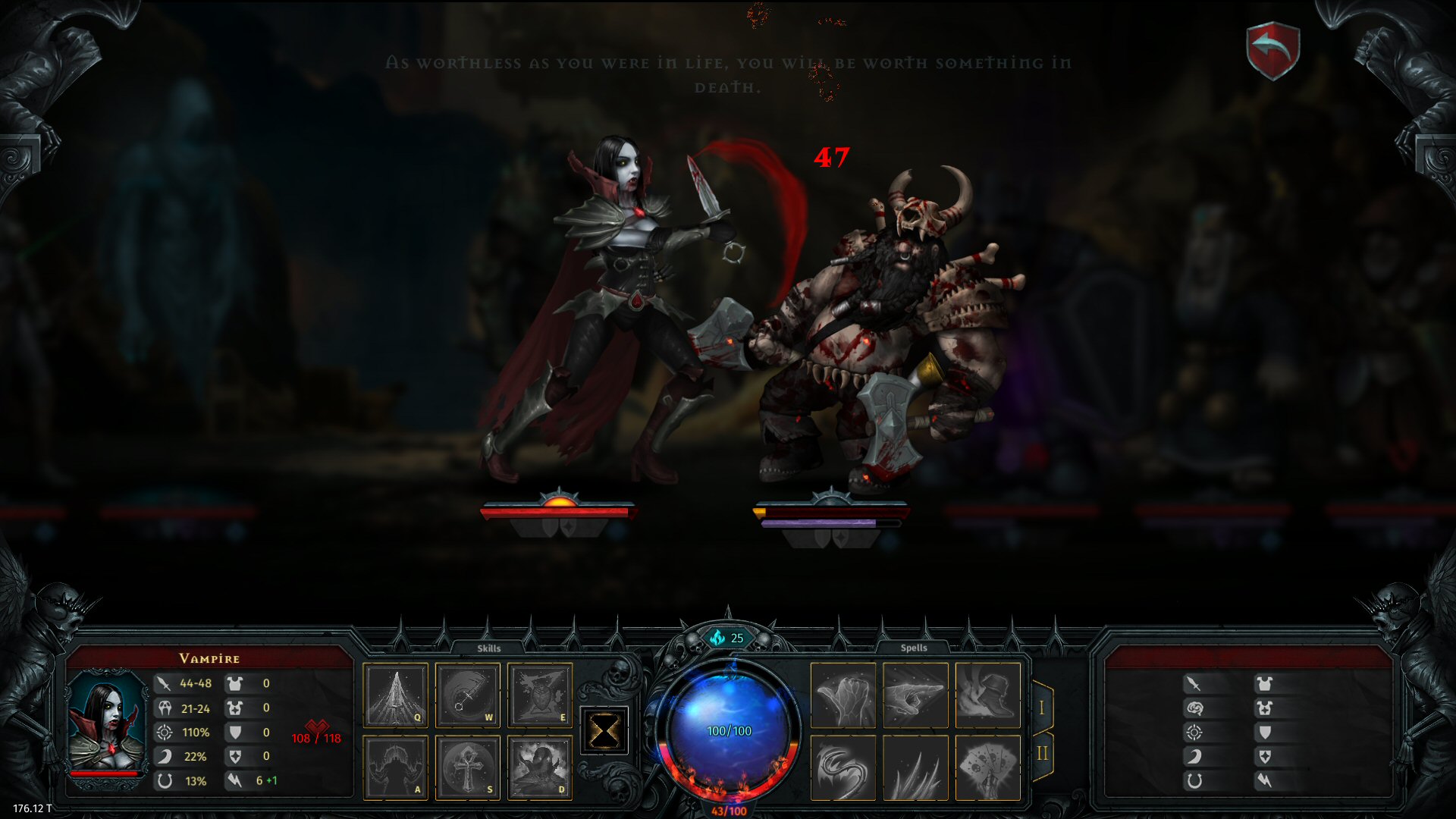
Gameplay – Management
The game spans 5 big thematic dungeon areas, starting with mining caves and ending with the high magister’s cathedral. Each of these areas has its own enemy types, so each time we go into the next area, we need to learn new enemy weaknesses and behaviours and adjust our strategy accordingly.
The dungeons themselves are viewed on a map screen, where we choose a path to take through them. Unfortunately we are not able to backtrack and return to paths we’ve not taken, so in that sense, it is impossible to grind or farm for items, and we have to make do with what we find on our way. Gladly we can see each path in front of us perfectly, as well as all the points of interest on each one, so we can plan our route based on what it is we desire – whether it’s coffins full of goodies or places that can raise our experience level. At each path there are also numerous enemy squads. We can see where they all are, but we are not able to see which enemies are part of the troop until we’re one space away from that particular troop.
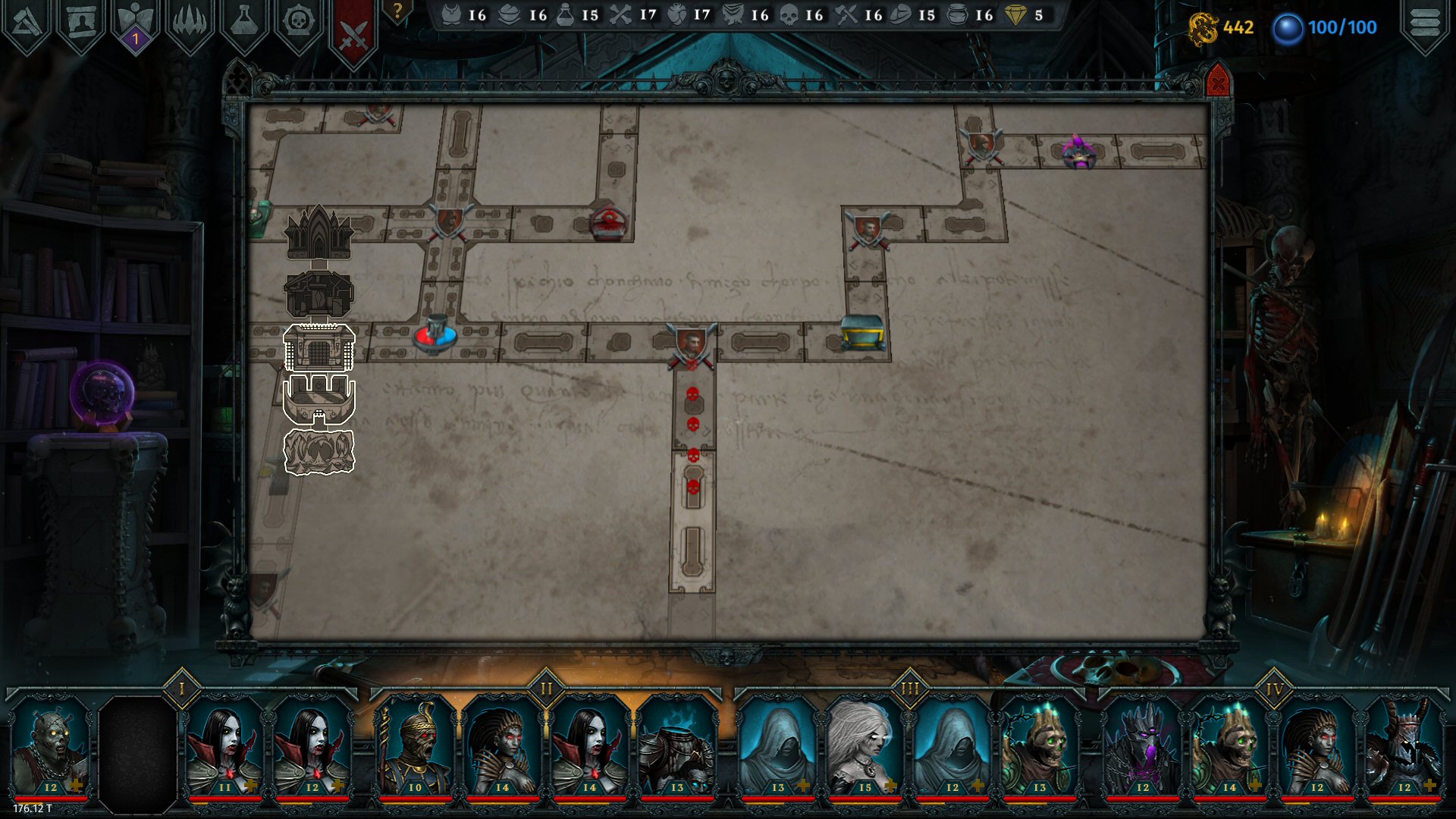
On some paths there are also sidequests. Some of those are merely a single battle, while others offer us interesting choices which can help us in our campaign, such as granting us new minions, new items, or weakening the enemies in some way for a certain number of battles.
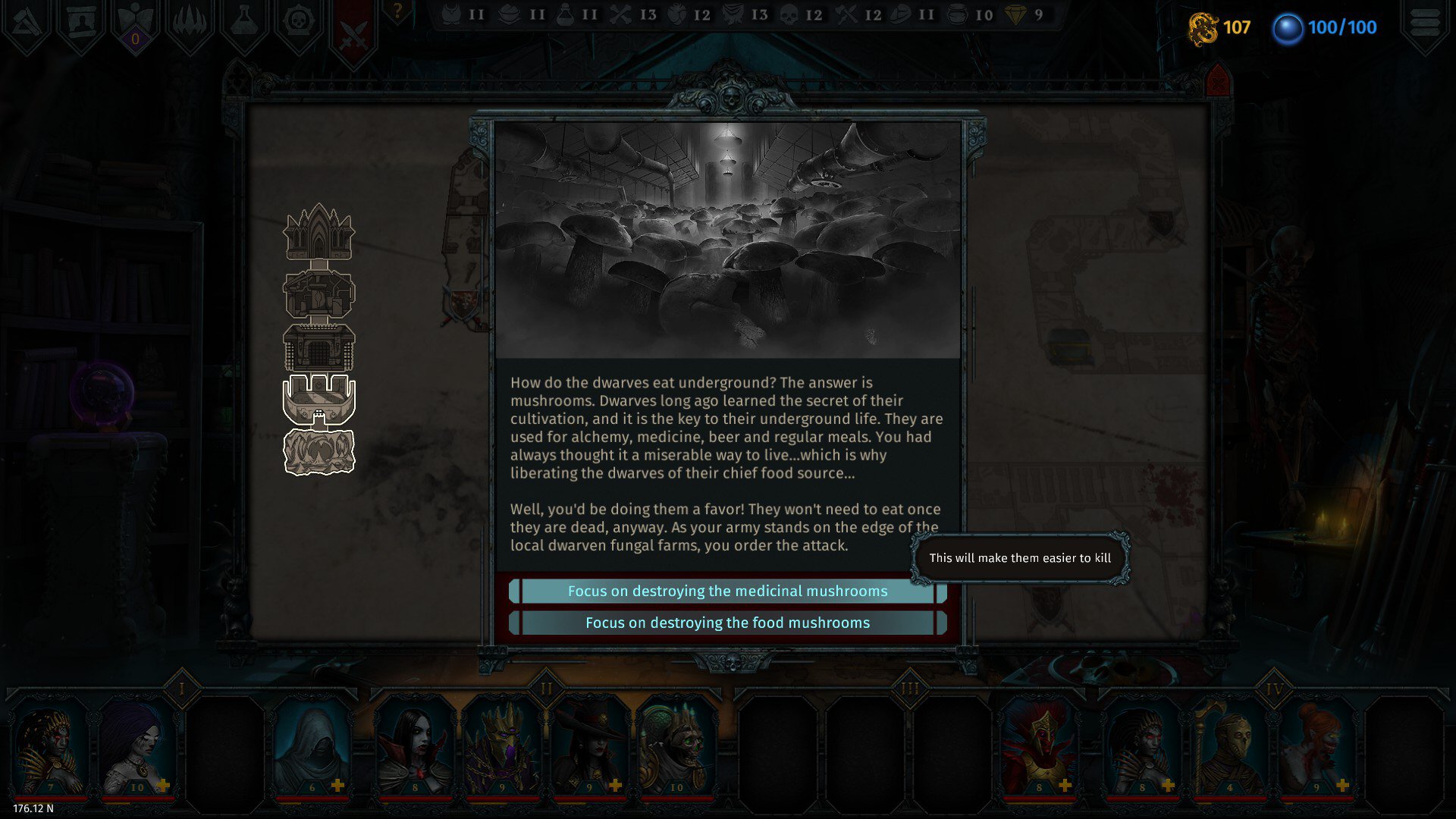
In this sense, the dungeon crawling mechanics are totally different to games like Darkest Dungeon. There are no individual dungeon runs here but rather one giant dungeon with many paths. We can change minions in our team in between each battle, and there are no bad points of interest that could hurt us. There is also no camping and things of this sort, as you’d imagine undead minions don’t have a need for such things.
When we’re in Iratus’ lair in between battles, we can do many things. One of the most important things is crafting minions out of body parts of slain enemies. After each battle we win, we acquire different body parts, be it bones, flesh, heart, dust, armour, and so on. Each minion has its own requirement of body parts needed to create it. If you have all the sufficient body parts, you can create that minion. So, in this sense, if you do run out of body parts and lose all your minions, it’s game over, but there’s a lot we can do before we reach that stage and it’s not likely in the first two difficulty levels, as we find a tonne of body parts over the course of our campaign.
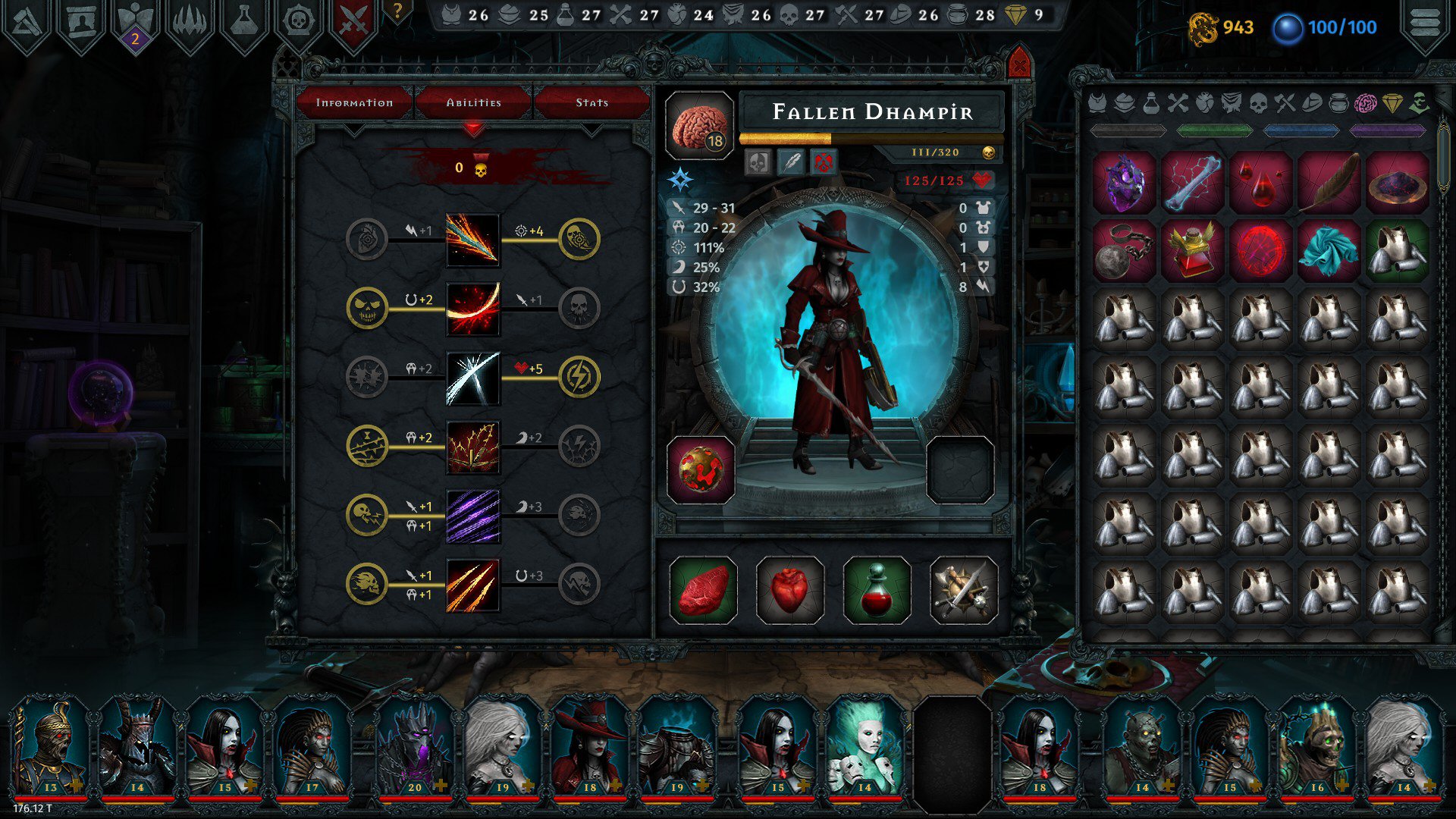
Speaking of difficulty levels, the game offers 4 of them which we pick at the start: Cakewalk (Easy), More Pain (Normal), Good Always Wins (Hard), Eternal Harvest (Very Hard). It is recommended to start with the Cakewalk, and in fact the game’s mandatory tutorial is done in this difficulty. After the tutorial ends, we can choose to continue on this difficulty or to restart from the beginning at another difficulty. However, the game does require a lot of strategy and has many mechanics and different types of enemies to face, and new players that get ahead of themselves could find themselves overwhelmed and put off very quickly.
During battles we also often find the brain body part. The brain has a certain level attached to it. By replacing any minion’s current brain with the new one, we instantly level them up to the level the new brain has. This is very useful for quickly getting a new minion to the required level and saves us the trouble of grinding, which is an incredibly great idea for a game such as this.
In Iratus’ lair we also have the Graveyard. This place consists of several different buildings. As we gain ‘souls’ throughout the campaign, we can build and upgrade these buildings. Each building offers a unique benefit. For example, one increases Iratus’ experience point gain, another one has a chance to bring in an artifact after each battle, third one can restore health to injured minions, and so on.
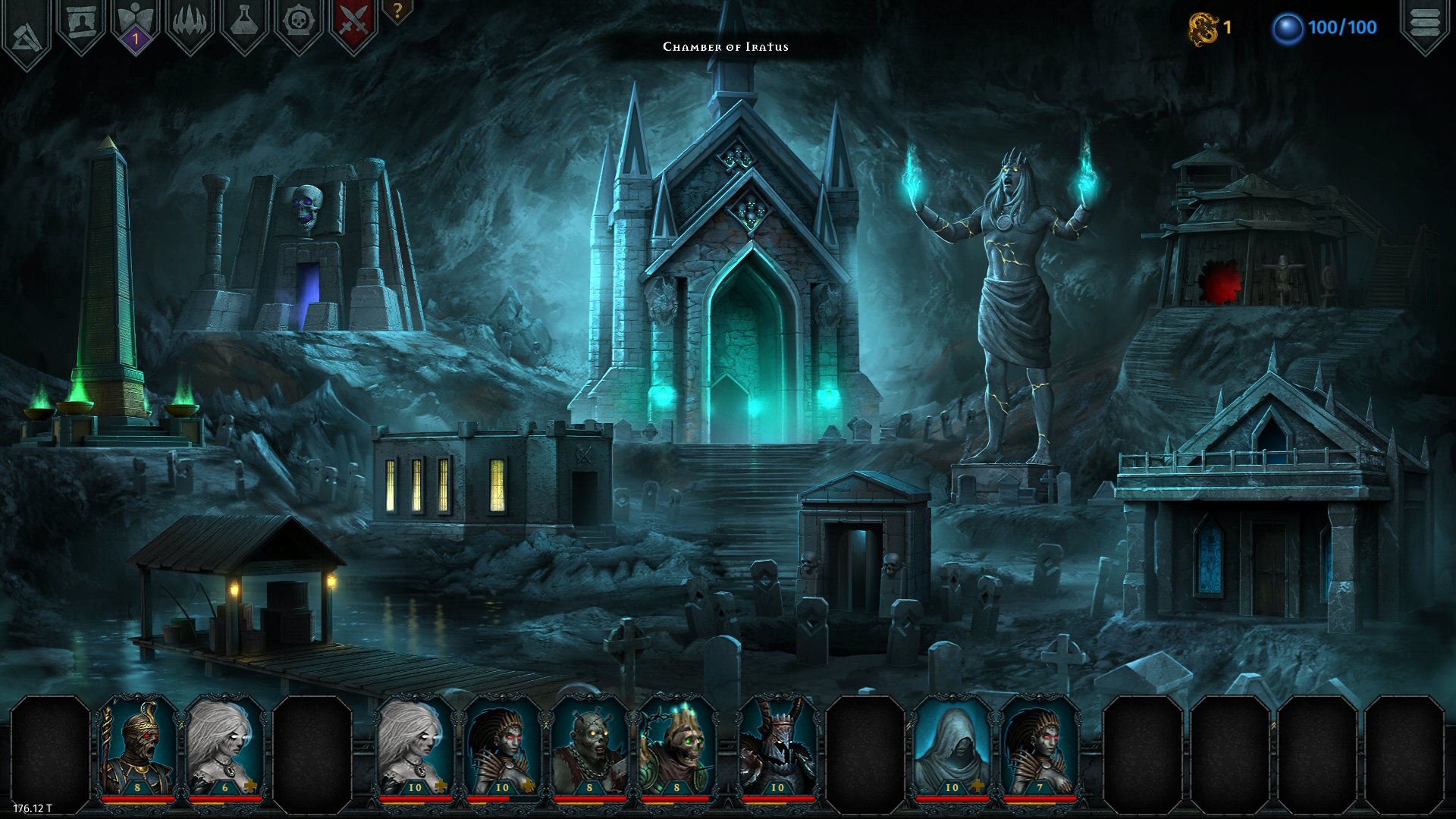
Lastly, in the lair we can also get Iratus to learn new skills as he levels up, some of which are passive, while others are active skills that can be used in battles. We can also equip artifacts to Iratus here with various benefits. And also we can do some alchemy to use body parts we have into restoring mana and crafting new things. So, with all these mechanics, the game offers plenty of ways to get stronger and overcome the challenges ahead.
Presentation
The game has a very nice visual style, with each minion and each environment crafted with incredible detail. Each minion is fully animated during their attacks and their animations are smooth and satisfying. The UI is also clear at all times and does well at showing all the information the player needs. The dungeon map screen might seem rather simplistic but is pleasant to traverse through and does what’s intended. Numerous icons for artifacts, body parts, skills and abilities are all nicely designed and easy to recognize, and in a game such as this, with so many items and skills, this is important.
The music is fairly decent and fits the game’s theme. I didn’t find it to be particularly memorable or stand out above most other soundtracks, but it’s not bad either. Sound effects are all well-chosen for each action, and voice acting is also quite good. Most of the voice acting is for Iratus himself as he often remarks on various situations in combat. It’s not quite as epic as Darkest Dungeon’s ancestor, in my opinion, but still decent.
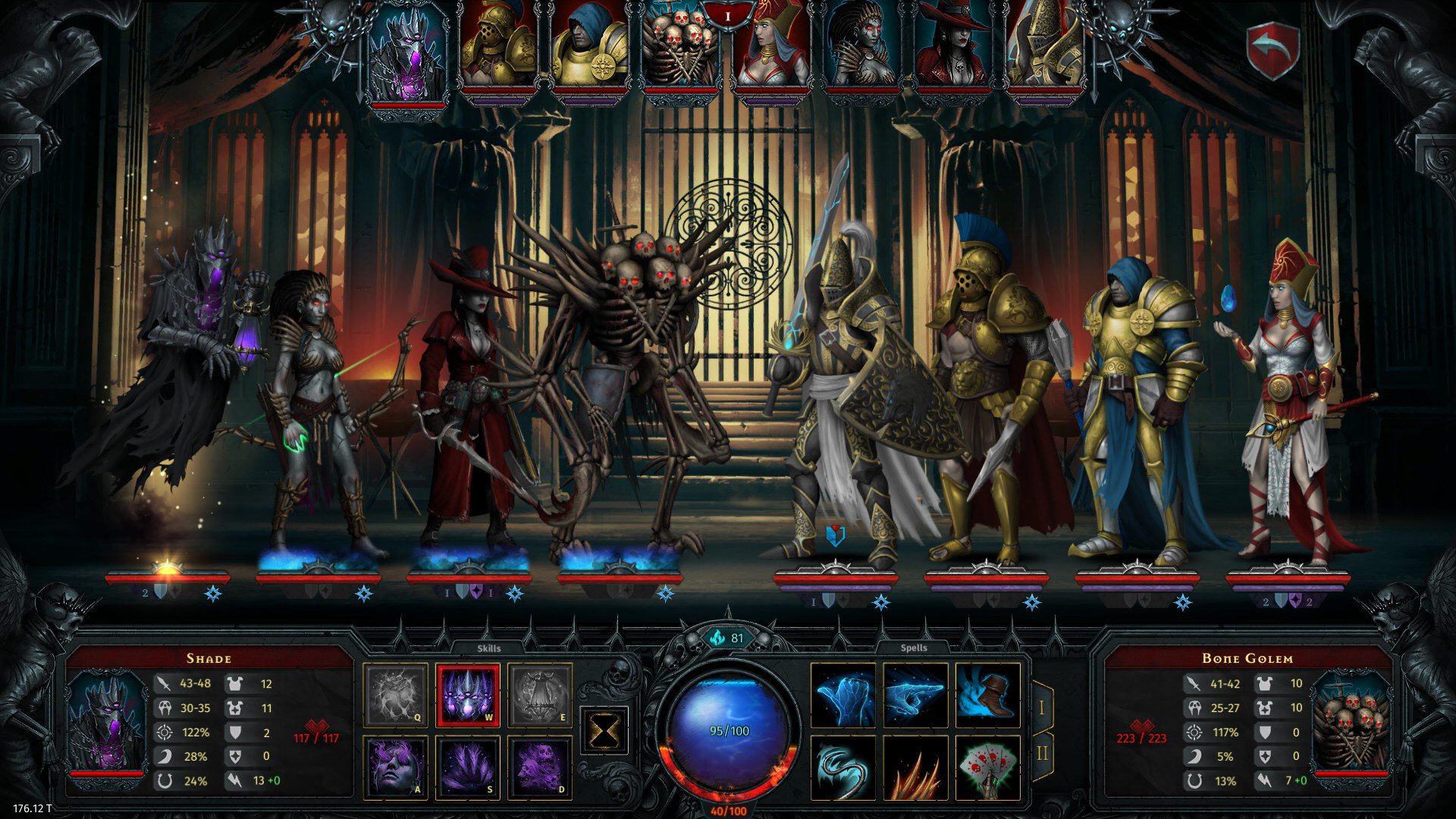
Verdict
I really enjoyed this game and I found myself addicted to it like a little kid to chocolate. When not playing it, I often thought about how to improve my in-game strategy and team composition in tackling the challenges that the game offers. With so many minions at our disposal, the team combinations are incredibly numerous, and the best thing is that majority of those minions are pretty fun to use and can be made very useful if the player knows how to use them properly.
With the way its combat is designed and much of the interface, it’s easy to see why most people would compare it to the Darkest Dungeon. The two games do overlap in many regards, but also have their big differences too. And just as with Darkest Dungeon, Iratus also manages to have an incredible amount of depth in how much it allows us to fine-tune our strategy and experiment with new ones. So if you loved Darkest Dungeon, there is a very good chance you’d have a blast with Iratus too, though admittedly there are some people who liked one but not the other.
With games like these, there’s always that criticism of them feeling repetitive, but I think with the amount of strategic depth we have at our disposal here, this game is a lot less repetitive than most other dungeon crawlers and tactics games. With the way it has 4 different difficulty levels, if someone finds it too repetitive, they can always try their hand at one of the harder difficulty modes that would test them better. Likewise, the Cakewalk difficulty makes the game feel quite accessible for newcomers to the genre and allows for more experimentation, so the right level of difficulty exists for a wide range of players and should appease most people who enjoy tactics and strategy.

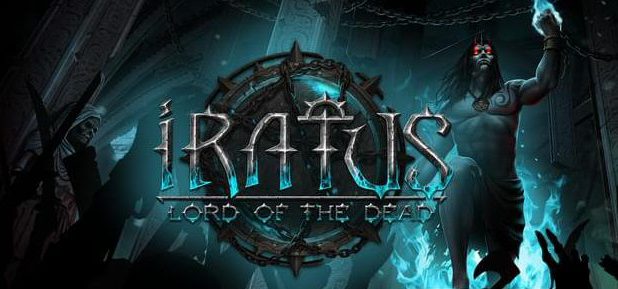









It’s not the same as Darkest Dungeon, it plays differently, in this, your minions are quite expendable, in fact, the game pretty much kills them as you go along and you make new ones from the body parts of the enemies you kill. The gameplay is also different in battle as are the many buildings you create and then staff with your minions. To compare this with the Darkest dungeon is like comparing Quake to Prey, they both look similar but play totally different.
Thanks for your comment. I think with any similar games there will be similarities and differences. I’d argue that the similarities in gameplay between Iratus and Darkest Dungeon are pretty big. They both use 4 vs 4 turn-based fights with position-sensitive skills and ability to shift the units in positioning throughout the fights dynamically. I’d also argue that expendability of units is not that much different. We can treat minions in Iratus as expendable, but we can treat adventurers in DD also that same way as we get free ones off the Stage Coach every week. But with both of these games, treating them as expendable pawns is not preferred as we spend resources and time into improving them. There are differences of course, as I covered in the review, in that Iratus focuses on combat a lot more, whereas DD has a lot of exploration of the dungeons and interaction with the curios. Lastly, let’s not forget that the devs of Iratus themselves have admitted that Darkest Dungeon was one of the main inspirations for their game.